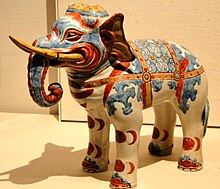Kakiemon elephants (British Museum)
| Kakiemon elephants | |
|---|---|
 on display in the museum | |
| Material | porcelain |
| Size | Height: 35.5 cm Width: 44 cm Length: 14.5 cm |
| Created | 1660-1690 Edo period |
| Place | Arita, Japan |
| Present location | Room 92-94, British Museum, London |
| Identification | 766883 |
| Registration | 1980,0325.1-2 |
The Kakiemon elephants are a pair of 17th century
Description
The figures are largely based on Asian elephants but differ slightly in some details. Like Dürer's Rhinoceros this is art based on the best information available. The artists who made these figures had never seen a real elephant and had to work from drawings and sketches; possibly from Buddhist sources.[3] They are made from enamelled porcelain, which would have been a new technology in Japan at the time they were made. Each elephant is 35.5 cm high, 44 cm long and 14.5 cm wide. The novel near-white glaze which is called 'nigoshide' was developed in this Japanese pottery in the seventeenth century.[4] 'Nigoshide' is known for its whiteness and is named after the residue that is left after washing rice.[5] The white ground is decorated with the additional characteristic coloured glazes of red, green, yellow and blue.[2]
Provenance

These ceramics came from the pottery of
The elephants are now in the British Museum, as part of the collection donated by Sir Harry Garner.
Importance
The emergence of enamelled porcelain near Arita in Kyushu began Kakiemon-style decoration in overglazed coloured enamels. The success of the Japanese was due to the disruption of the Chinese
The milk-white glaze called 'nigoshide', developed by Kakiemon, was out of use by the end of the Edo period. However the technique was rediscovered in 1953 by Sakaida Kakiemon XII (1878–1963) and Sakaida Kakiemon XIII (1906–1982) and was declared a Japanese "Important Intangible Cultural Asset" in 1971. Kakiemon porcelain continued to be made under Sakaida Kakiemon XIV until his death in June 2013.[5]
There are few artefacts like this pair of elephants extant although there is a similar elephant (c.1680) in the Groninger Museum in the Netherlands and another in the Fitzwilliam Museum in Cambridge.[3]
A History of the World in 100 Objects
This sculpture was featured in A History of the World in 100 Objects, a series of radio programmes that started in 2010 as a collaboration between the BBC and the British Museum.[6]
References
- ^ a b Japan: Its History, Arts and Literature. Volume 8 Archived 2011-07-24 at the Wayback Machine, Frank Brinkley, p.112, accessed September 2010
- ^ a b Kakiemon elephants, British Museum, accessed 6 September 2010
- ^ a b c Object of the Month November Archived 2011-07-24 at the Wayback Machine, Groningen Museum, accessed 6 September 2010
- ^ a b Japan encyclopedia by Louis Frédéric p.455, accessed 6 September 2010
- ^ a b Kakiemon Sakaida, ExploreJapaneseCeramics, accessed 7 September 2010
- ^ A History of the World in 100 Objects, BBC. accessed 5 September 2010
